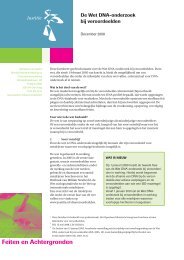INTERPOL HANDBOOK ON DNA DATA EXCHANGE AND PRACTICE
INTERPOL HANDBOOK ON DNA DATA EXCHANGE AND PRACTICE
INTERPOL HANDBOOK ON DNA DATA EXCHANGE AND PRACTICE
Create successful ePaper yourself
Turn your PDF publications into a flip-book with our unique Google optimized e-Paper software.
The more crime types and suspects there are in a national <strong>DNA</strong> Database, the highera country’s crime detection rate will be. National databases often have match ratesfor linking a crime scene profile with a previously stored person (between 20-50%). Itis therefore clear that <strong>DNA</strong> Databases can be used to solve high-volume crimes suchas burglary or car thefts which are traditionally very difficult crimes to solve by othermeans. <strong>DNA</strong> Database research has also shown that perpetrators often do not limitthemselves to one crime type. For example, it has been known for <strong>DNA</strong> profiles fromunsolved murders to be matched in a database containing offenders’ profiles for muchmore minor crimes, such as theft. The chance of finding a match for an unsolved crimescene profile thus increases with the number of potential criminal profiles stored. Thepotential of <strong>DNA</strong> Databases to assist with investigations was immediately realized bythe law-enforcement agencies using them. This success has an ongoing impact on thepolitical standpoint, resulting in less restrictive legislation regarding the crimes or thepersons for which <strong>DNA</strong> samples may be analysed and stored. It has also resulted in aconsiderable increase in database sizes over the last decade. The sizes of some of theexisting databases are shown in the following table.Table 4: number of profiles in <strong>DNA</strong> Databases for <strong>INTERPOL</strong> member countries(on your right)The total number of profiles provided as ‘Reference’ profiles is a combination of severalcategories: ‘Convicted’, ‘Suspect’, ‘Victim’ and ‘Other’. A comprehensive analysis of<strong>DNA</strong> use and profiling categories around the world can be found on the <strong>INTERPOL</strong>restricted website www.interpol.int in the document entitled «<strong>INTERPOL</strong> Global<strong>DNA</strong> Profiling Inquiry- Results and Analysis 2008». Additionally, statistics on European<strong>DNA</strong> Databases are available on the public ENFSI website.PAGE 54STATUS <strong>ON</strong> EXISTINGNATI<strong>ON</strong>AL <strong>DNA</strong> <strong>DATA</strong>BASES







